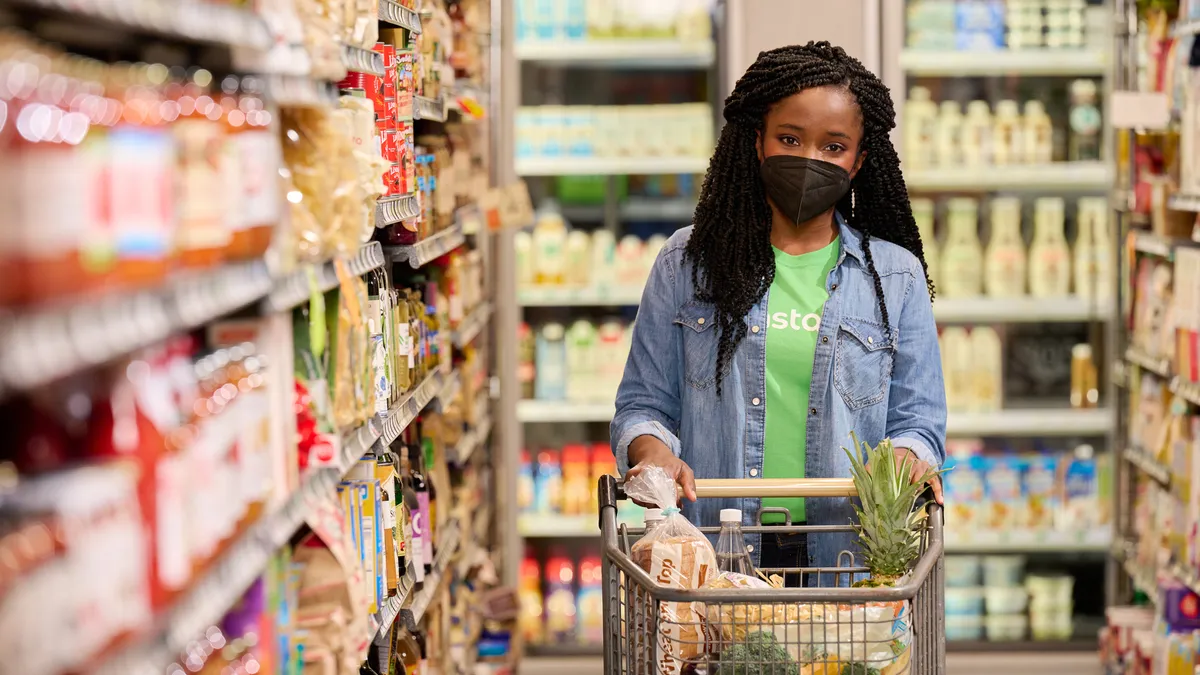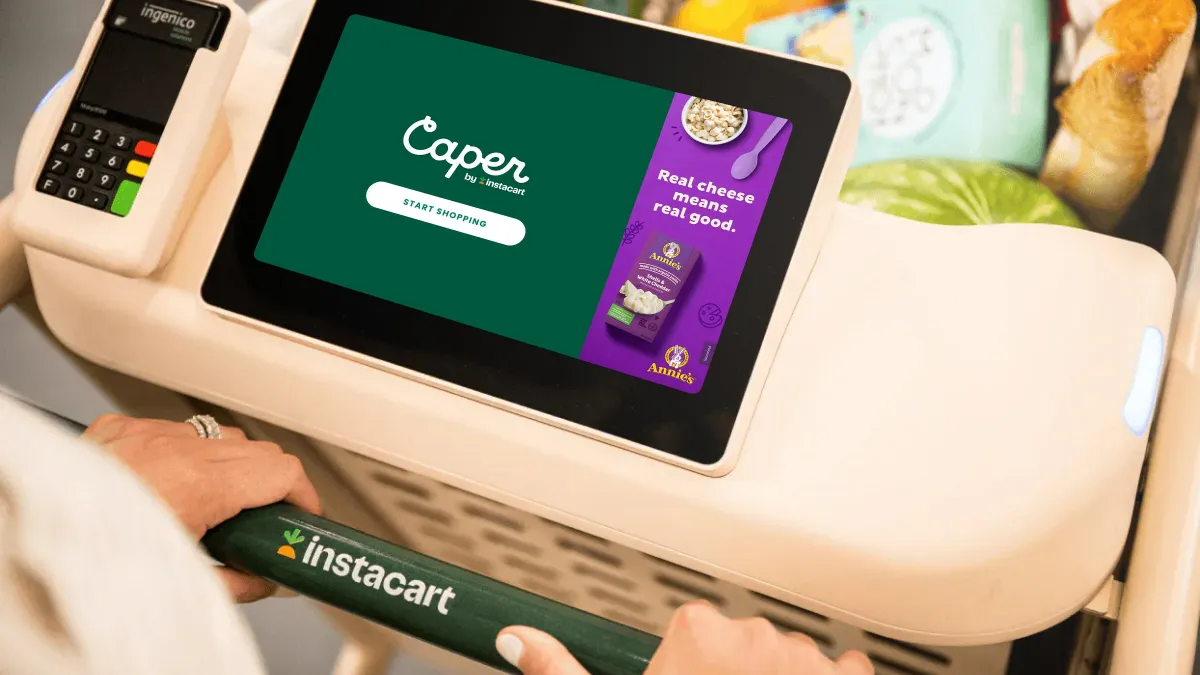Pardon the Disruption is a column that looks at the forces shaping food retail.
The past several days have been a whirlwind for Instacart, and it now feels as if the company that has been such a foundational piece of the online grocery landscape is suddenly facing an uncertain future.
Just to recap: Instacart unveiled a new visual marketing package, including a logo that refashions its carrot icon as a digital shopping tool. A few days later, it rolled out Instacart Platform, a suite of technology services that includes ad support, consumer insights and warehouse fulfillment — letting retailers that have increasingly chafed against its powerful marketplace know that they can now use those same marketplace tools to fuel their digital businesses. Then, just one day later, news came out that Instacart has severely reduced its valuation, from a pandemic-juiced $39 billion down to around $24 billion.
It’s clear that the first two developments during that several-day period are in response to what came at the end. The pandemic launched Instacart into the stratosphere, and now that shoppers have returned to stores in droves, it has returned once again to Earth’s orbit.
As Instacart rightly pointed out, it’s not the only tech company that’s falling out of favor with investors as e-commerce demand has slowed while inflation has soared. DoorDash, the restaurant delivery company that’s quickly becoming Instacart’s bitter rival in e-grocery, has seen its stock plummet nearly 50% over the past six months.
But there’s more that’s rattling Instacart than just market forces. The company that used to be so indispensable to grocers’ online selling strategies is seeing those grocers increasingly push back against it, frustrated by the way its marketplace has monetized shoppers and controlled the experience of buying products that come from their stores.
"Many of the retailers I've talked to that have a relationship with Instacart are looking to move away from Instacart," said Gary Hawkins, CEO of the Center for Advancing Retail & Technology, who consults with grocers.
That marketplace still accounts for more than half of all online grocery sales, a dominance that’s made unplugging actually much more difficult than it sounds. Growth has slowed, which is to be expected. But the latest figures from Bloomberg Second Measure show that sales appear to have entered a steady decline, down each month between November and February, the latest month for which data is available.
Instacart is facing an inflection point in its business and not for the first time. It effectively ramped up service during the pandemic, becoming a lifeline for shoppers and retailers. And industry readers are very familiar with the way the company capitalized on Amazon’s acquisition of Whole Foods and the ensuing digital anxieties grocers held.
Those successes, however, relied in large part on Instacart's marketplace. With its lineup of services for grocers and other retailers, the company is pushing outside that cornerstone property into new services that are less familiar to it.
I certainly wouldn't count the company out, given its track record, but remaining the high-flying digital grocery player it's been for several years now will be very difficult.
Platform takes center stage
Instacart CEO Fidji Simo noted in a blog post last week that Instacart Platform amounts to a “third act” for the company, following on its initial online push and the start of its service offerings for retailers, which up until now have focused mainly on building digital storefronts.
Simo’s reference summons the language of the theatre, with its rising and falling action building towards what, in hindsight, looks like an inevitable conclusion. So will Instacart’s latest major pivot keep the company flying high, or will it unwind into a tragic ending?
It's important to note that Instacart isn’t new to offering white-label services for retailers. It’s built apps and digital storefronts for retailers like The Fresh Market and Wegmans over the past few years, following its acquisition of web developer Unata in 2018, and also offers delivery as a service.
But Instacart Platform still feels like a precarious Plan B because it's venturing further beyond the company's core marketplace and pitting it against a slew of competitors across its new and existing services.
In Instacart’s telling, Platform is the next step in the long and fruitful partnerships it’s had with retailers. Its press release last week included a litany of quotes from grocers in support of its various services, as if to overemphasize the idea that everyone is getting along just fine.
Many of those quoted are regional grocers, like Good Food Holdings and Key Food, that need to keep pace in the digital arms race but don’t have the capital to invest deeply across ads, fulfillment, last-mile delivery and other capabilities. Simo was absolutely spot on in her post when she stated that “the technologies required to power a grocery operation are only getting more complex.”
But will a lot more grocers want to deepen their relationship with the company whose retailer tie-ups were once characterized as an "addiction" by a prominent Wall Street analyst?
As Simo noted, small and mid-sized grocers need to forge strategic partnerships in order to stand up the many digital tools customers and CPGs are demanding. Unlike 2017, however, retailers do not need Instacart to get this done. There are numerous dedicated firms in areas like ad support, insights and fulfillment that have linked up with retailers. For some companies that offer branded pickup and delivery services as an alternative to Instacart’s marketplace, one of their main goals right now is figuring out how to siphon shoppers away from that marketplace and into their own channels.
And yet, in the twisty, rapidly changing world of e-commerce, enemies can become friends, or even frenemies, overnight. Instacart may very well offer the best tools for the job, and they deserve to be evaluated fairly by retailers.
The trouble with warehouses
The tech company’s biggest service opportunity, but also its weakest capability, may be in fulfillment. After relying for so many years on grocery stores to fill online grocery orders, Instacart is now getting into dark stores, or "Carrot Warehouses," which require a new degree of planning, construction and operational sophistication.
It has hired experts to help build out this capability, and last week announced it will open “nano-fulfillment” centers to serve Publix customers in Atlanta and Miami. Instacart linked up with automated fulfillment firm Fabric last summer, though last week it said that company is not currently affiliated with Carrot Warehouses.
There are a slew of providers that can also build dark stores, many of them with years of experience in warehouse operations. This includes DoorDash, which plans to offer the DashMart online convenience stores it’s been running for nearly two years now as a service. Gopuff, a leader right now in rapid delivery, may also move into the space, having just announced it’s providing rapid delivery for products from U.K. grocery chain Morrisons.
No doubt, the opportunity in dark stores and rapid delivery is going to be massive in the years ahead as retailers add ultrafast service to their growing suite of delivery options in pursuit of young shoppers and impulse trips. Already, Instacart has leapt out of the starting gate by utilizing one of its greatest assets — its army of gig workers — to deliver curated instant-needs assortments from Kroger, Publix and Ahold Delhaize’s U.S. stores.
Celia Van Wickel, senior director of digital commerce at Kantar, said Instacart's 30-minute delivery service is an example of how nimble the company has managed to be as the online grocery landscape has shifted. "They keep finding new reasons for the retailers to reengage," she told me.
But as rapid delivery inevitably expands into dark stores, will Instacart be able to keep that business? Kroger executives talked during a recent business update about the importance of using its stores to fill immediate delivery needs, which plays into Instacart's hands. At the same time, the company is going to start opening micro-fulfillment sites with tech partner Ocado that could end up taking over a large part of that rapid delivery business.
"I do think that Kroger will one day walk away from Instacart," Van Wickel said.
The loss of large grocery chains like Kroger, which have been instrumental to Instacart's rise, would be a major blow to Instacart, she said. That makes it all the more vital for the company to prove its value to smaller companies that have significantly less money to spend.
Ad sales and tying everything together
Instacart has a lot of potential to succeed in dark stores and rapid delivery, but it also has a steep learning curve and little margin for error.
Ad sales and data insights, on the other hand, are two areas where Instacart currently excels, Hawkins and Van Wickel both told me. Retailers are all too familiar with Instacart’s data-gathering capabilities via its marketplace. And ever since Instacart named Simo, a former Facbook advertising executive, as its CEO last year, the company has added high-profile ad executives and made deepening its bench of advertising products a major priority.
Any retailer looking to use Instacart’s services should thoroughly investigate what the company is offering and make sure they’re not just adding further fuel to its marketplace. Will Instacart be able to provide effective guidance to accompany the data it shares with retailers? Small grocers don't generate a lot of traffic, so how will Instacart make their apps and websites attractive to CPG ad buyers?
Van Wickel said she'll be watching to see if Instacart can sell its services to retailers beyond the ones it's currently partnered with: "How did they grow this retail media network? And do they expand it, ideally, beyond these core partners?"
Instacart’s greatest asset here may be the ability to tie multiple services together. Grocers now treat digital retailing as a network operation, with consumer data feeding advertising, which in turn helps fuel the storefronts that can deepen shopper loyalty, and so on. Companies are also testing out ways to add in-store data to the mix through tools like smartphone scanning and smart carts — another Instacart service.
Grocers will keep upgrading their digital capabilities and pulling in more customers to use them, and Instacart wants to continue playing a key role in that story. But it will have to do a lot more than power storefronts and its signature marketplace. It will need to effectively power digital ecosystems for retailers, as well.




















